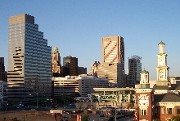Sun: Gap Gives City Its Chance
A good article on Baltimore City's recent gains and potential for growth over the next ten years. (The "Gap" here refers to housing price stratification, not to the predominantly white suburban middle-class retailer, which might deserve an urban socioeconomics article in its own right.)
From the article:
The connections between Light Rail and Metro are poor, and the connections between the Metro and any commuter rail services are ridiculous. The entire eastern half of the City east of Charles Street has no rail service, none - except one entrance of the CHarles Street Metro, the Shot Tower station 5 blocks east of there and Johns Hopkins Hospital 1.5 miles away. Nothing in Belair-Edison, Govans, Northwood, Morgant State, Fells Point, Dundalk-City Side, Highlandtown, Greektown, Canton, Butchers Hill, Cedonia, Hamilton, Loch Raven, Waverly, Charles Village, Homeland, or Guilford. The MARC does have a West Baltimore Station but an East Baltimore station north of Hopkins Hospital would do wonders.
Some of my complaints are addressed in the Baltimore Region Transit Plan (formerly known as the Baltimore Rail Plan, before timidity or transit hostility from the Transportation Department downgraded the infrastructure ambitions from rail to bus), though the current Governor and Secretary of Transportation appear rather cool to transit. In fairness to Transportation Secretary Robert Flanagan, whom I have criticized harshly here at FSP and somewhat less harshly at my own blog Crablaw, Flanagan is probably more pro-transit than the current Bush administration, whose political base (rural people, white people, Southerners, oil industry, anti-tax advocates) is largely adverse or indifferent to transit.
There are things you can do to help transit flourish. If people could get around Baltimore without a car half as well as they can in Washington, Baltimore's trickle of new residents would become a flood. Car insurance rates make car ownership horrible in the city, let alone theft rates, but good transit within the city and improved access to the MARC would bring in (...drumroll please...) DC and Montgomery County yuppie money.
An increased tax base from new owners and improved values would allow the tax rates to mitigate somewhat, reducing the municipal scalping one suffers for crossing the City-County line, which would in turn increase values more for investors (i.e. if rental property becomes more profitable in net spendable after taxes ease down, the increased income stream justifies a higher purchase price.) Then the yuppies bring their cash, then you get gyms and Starbucks. Even lower-income residents benefit from this, as the "ghetto tax" gets reduced as access to better goods and services - and jobs! - within the city increases. I am looking for the down side here, but cannot find it.
Once in a while in life you get a virtuous cycle, but for Baltimore it will improve with improvements to transit infrastructure. And lattes.
From the article:
Baltimore has been a city of sharp contrast. Neighborhoods such as Federal Hill, Canton and Hampden have undergone a remarkable rebirth, with new residents and soaring property values, and the impact has been spilling over into adjacent areas. But other parts of the city remain bleak, pockmarked with houses that no one wants and persistent hopelessness.While the article did discuss crime, taxes, schools and the attractiveness of Baltimore for Washington commuters, it did not discuss at all one of Baltimore's greatest weaknesses: public transit that relies on slow-moving busses on tight streets. Baltimore's Light Rail grazes the central business district but does not really penetrate it, and its connections to Penn Station are poor. (Now it's a one stop shuttle between Penn Station and Mt. Royal, but it runs so infrequently that it is generally quicker for a non-disabled citizen to walk that 1/4 mile after disembarking from a Penn Station or mainline Light Rail train. Plus the station at Mount Royal has poor shelter, so it's not as if you could avoid the rain either way.)
The large-scale projects in the works could jump-start change in new places - if the developers pull them off.
"Size is important when you're trying to redevelop an area because you're trying to create a critical mass," said John K. McIlwain, senior fellow for housing with the Urban Land Institute. He spent four years running a fund that invested in developing urban neighborhoods.
Infusing - or creating - a neighborhood with hundreds of working people can change the dynamics quickly. It fosters a sense of safety in numbers, not the dangerous frontier of the urban pioneer. It means more residents with the resources to keep up appearances, greater buying power of the sort that can attract coveted retailers and services, plus increased property and income taxes for the city. And if middle-class families move in and use the local public schools, that too can have an effect and broaden support for educational improvement.
...
Some of the new construction is happening in marginal neighborhoods in those areas. For instance, workers are building a 32-townhouse project on Calvert Street close to Penn Station - and near numerous boarded-up homes. As Jeni Paik puts it, "That area is still a little scary right now." But she's buying one of the townhouses anyway and moving from nearby Mount Vernon, where she has seen improvements in her five years of Baltimore living.
"I have faith that the Station North area is going to get better too," said Paik, 26.
The connections between Light Rail and Metro are poor, and the connections between the Metro and any commuter rail services are ridiculous. The entire eastern half of the City east of Charles Street has no rail service, none - except one entrance of the CHarles Street Metro, the Shot Tower station 5 blocks east of there and Johns Hopkins Hospital 1.5 miles away. Nothing in Belair-Edison, Govans, Northwood, Morgant State, Fells Point, Dundalk-City Side, Highlandtown, Greektown, Canton, Butchers Hill, Cedonia, Hamilton, Loch Raven, Waverly, Charles Village, Homeland, or Guilford. The MARC does have a West Baltimore Station but an East Baltimore station north of Hopkins Hospital would do wonders.
Some of my complaints are addressed in the Baltimore Region Transit Plan (formerly known as the Baltimore Rail Plan, before timidity or transit hostility from the Transportation Department downgraded the infrastructure ambitions from rail to bus), though the current Governor and Secretary of Transportation appear rather cool to transit. In fairness to Transportation Secretary Robert Flanagan, whom I have criticized harshly here at FSP and somewhat less harshly at my own blog Crablaw, Flanagan is probably more pro-transit than the current Bush administration, whose political base (rural people, white people, Southerners, oil industry, anti-tax advocates) is largely adverse or indifferent to transit.
There are things you can do to help transit flourish. If people could get around Baltimore without a car half as well as they can in Washington, Baltimore's trickle of new residents would become a flood. Car insurance rates make car ownership horrible in the city, let alone theft rates, but good transit within the city and improved access to the MARC would bring in (...drumroll please...) DC and Montgomery County yuppie money.
An increased tax base from new owners and improved values would allow the tax rates to mitigate somewhat, reducing the municipal scalping one suffers for crossing the City-County line, which would in turn increase values more for investors (i.e. if rental property becomes more profitable in net spendable after taxes ease down, the increased income stream justifies a higher purchase price.) Then the yuppies bring their cash, then you get gyms and Starbucks. Even lower-income residents benefit from this, as the "ghetto tax" gets reduced as access to better goods and services - and jobs! - within the city increases. I am looking for the down side here, but cannot find it.
Once in a while in life you get a virtuous cycle, but for Baltimore it will improve with improvements to transit infrastructure. And lattes.






1 Comments:
Interesting.
Post a Comment
<< Home